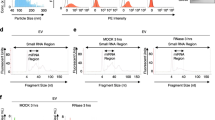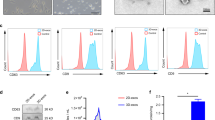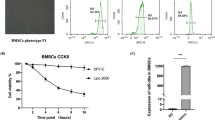Abstract
Cell-free based therapy is an effective strategy in regenerative medicine as it avoids controversial issues, such as immunomodulation and stability. Recently, exosomes have been explored as a favorable substitution for stem cell therapy as they exhibit multiple advantages, such as the ability to be endocytosed and innate biocompatibility. This study aimed to investigate the effects of stem cells from human exfoliated deciduous teeth (SHED)-derived exosomes (SHED-Exo) on bone marrow stromal cells (BMSCs) osteogenesis and bone recovery. SHED-Exo were isolated, characterized, and applied to the bone loss area caused by periodontitis in a mouse model. We found that the injection of SHED-Exo restored bone loss to the same extent as original stem cells. Without affecting BMSCs proliferation, SHED-Exo mildly inhibited apoptosis. Moreover, SHED-Exo specifically promoted BMSCs osteogenesis and inhibited adipogenesis compared with SHED-derived conditioned medium. The expression of osteogenic marker genes, alkaline phosphatase activity, and Alizarin Red S staining of BMSCs was significantly increased by co-culturing with SHED-Exo. Moreover, Western blot analysis showed that Runx2, a key transcriptional factor in osteogenic differentiation, and p-Smad5 were upregulated upon SHED-Exo stimulation. Expression of the adipogenic marker PPARγ and the amount of lipid droplets decreased when exosomes were present. Low doses of exosomes inhibited the expression of the inflammatory cytokines IL-6 and TNF-α. In conclusion, SHED-Exo directly promoted BMSCs osteogenesis, differentiation, and bone formation. Therefore, exosomes have the potential to be utilized in the treatment of periodontitis and other bone diseases.








Similar content being viewed by others
Data availability
The authors declare that the data supporting the findings of this study are available within the manuscript and the supplementary materials.
References
Abe T, Hajishengallis G (2013) Optimization of the ligature-induced periodontitis model in mice. J Immunol Methods 394(1–2):49–54
Alvarez-Erviti L, Seow Y, Yin H, Betts C, Lakhal S, Wood MJ (2011) Delivery of siRNA to the mouse brain by systemic injection of targeted exosomes. Nat Biotechnol 29(4):341–345
Bianco P, Cao X, Frenette PS, Mao JJ, Robey PG, Simmons PJ et al (2013) The meaning, the sense and the significance: translating the science of mesenchymal stem cells into medicine. Nat Med 19(1):35–42
Catalano M, O'Driscoll L (2020) Inhibiting extracellular vesicles formation and release: a review of EV inhibitors. J Extracell Vesicles 9(1):1703244
Chaput N, Taieb J, Schartz NE, Andre F, Angevin E, Zitvogel L (2004) Exosome-based immunotherapy. Cancer Immunol Immunother 53(3):234–239
Cui Y, Luan J, Li H, Zhou X, Han J (2016) Exosomes derived from mineralizing osteoblasts promote ST2 cell osteogenic differentiation by alteration of microRNA expression. FEBS Lett 590(1):185–192
Du ZH, Li SL, Ge XY, Yu GY, Ding C (2018) Comparison of the secretory related molecules expression in stem cells from the pulp of human exfoliated deciduous teeth and dental pulp stem cells. Zhonghua Kou Qiang Yi Xue Za Zhi 53(11):741–747
Du ZH, Ding C, Zhang Q, Zhang Y, Ge XY, Li SL et al (2019) Stem cells from exfoliated deciduous teeth alleviate hyposalivation caused by Sjogren syndrome. Oral Dis 25(6):1530–1544
Fang SH, Li YF, Chen P (2019) Osteogenic effect of bone marrow mesenchymal stem cell-derived exosomes on steroid-induced osteonecrosis of the femoral head. Drug Des Dev Therapy 13:45–55
Fitts CA, Ji N, Li Y, Tan C (2019) Exploiting exosomes in cancer liquid biopsies and drug delivery. Adv Healthc Mater 8(6):e1801268
Fleury A, Martinez MC, Le Lay S (2014) Extracellular vesicles as therapeutic tools in cardiovascular diseases. Front Immunol 5:370
Haniffa MA, Collin MP, Buckley CD, Dazzi F (2009) Mesenchymal stem cells: the fibroblasts' new clothes? Haematologica 94(2):258–263
Hayashi T, Hoffman MP (2017) Exosomal microRNA communication between tissues during organogenesis. RNA Biol 14(12):1683–1689
Heusermann W, Hean J, Trojer D, Steib E, von Bueren S, Graff-Meyer A et al (2016) Exosomes surf on filopodia to enter cells at endocytic hot spots, traffic within endosomes, and are targeted to the ER. J Cell Biol 213(2):173–184
Huang CC, Narayanan R, Alapati S, Ravindran S (2016) Exosomes as biomimetic tools for stem cell differentiation: applications in dental pulp tissue regeneration. Biomaterials 111:103–115
Jiang N, Xiang L, He L, Yang G, Zheng J, Wang C et al (2017) Exosomes mediate epithelium-mesenchyme crosstalk in organ development. ACS Nano 11(8):7736–7746
Kalluri R, LeBleu VS (2020) The biology, function, and biomedical applications of exosomes. Science 367:6478
Lee HS, Jeon M, Kim SO, Kim SH, Lee JH, Ahn SJ et al (2015) Characteristics of stem cells from human exfoliated deciduous teeth (SHED) from intact cryopreserved deciduous teeth. Cryobiology 71(3):374–383
Li X, Liu LY, Yang J, Yu YH, Chai JK, Wang LY et al (2016) Exosome derived from human umbilical cord mesenchymal stem cell mediates MiR-181c attenuating burn-induced excessive inflammation. Ebiomedicine 8:72–82
Li ZJ, Liu F, He X, Yang X, Shan FP, Feng J (2019) Exosomes derived from mesenchymal stem cells attenuate inflammation and demyelination of the central nervous system in EAE rats by regulating the polarization of microglia. Int Immunopharmacol 67:268–280
Liang QL, Bie NN, Yong TY, Tang K, Shi XL, Wei ZH et al (2019) The softness of tumour-cell-derived microparticles regulates their drug-delivery efficiency. Nat Biomed Eng 3(9):729–740
Liu YF, Gu Y, Han YM, Zhang Q, Jiang ZP, Zhang X et al (2016) Tumor exosomal RNAs promote lung pre-metastatic niche formation by activating alveolar epithelial TLR3 to recruit neutrophils. Cancer Cell 30(2):243–256
Ma L, Makino Y, Yamaza H, Akiyama K, Hoshino Y, Song GT et al (2012) Cryopreserved dental pulp tissues of exfoliated deciduous teeth is a feasible stem cell resource for regenerative medicine. PLoS ONE 7:e51777
Mao G, Zhang Z, Hu S, Chang Z, Huang Z, Liao W et al (2018) Exosomes derived from miR-92a-3p-overexpressing human mesenchymal stem cells enhance chondrogenesis and suppress cartilage degradation via targeting WNT5A. Stem Cell Res Ther 9(1):247
Mathieu M, Martin-Jaular L, Lavieu G, Thery C (2019) Specificities of secretion and uptake of exosomes and other extracellular vesicles for cell-to-cell communication. Nat Cell Biol 21(1):9–17
Milane L, Singh A, Mattheolabakis G, Suresh M, Amiji MM (2015) Exosome mediated communication within the tumor microenvironment. J Control Release 219:278–294
Miura M, Gronthos S, Zhao M, Lu B, Fisher LW, Robey PG et al (2003a) SHED: stem cells from human exfoliated deciduous teeth. Proc Natl Acad Sci USA 100(10):5807–5812
Miura M, Gronthos S, Zhao MR, Lu B, Fisher LW, Robey PG et al (2003b) SHED: Stem cells from human exfoliated deciduous teeth. Proc Natl Acad Sci USA 100(10):5807–5812
Nooshabadi VT, Verdi J, Ebrahimi-Barough S, Mowla J, Atlasi MA, Mazoochi T et al (2019) Endometrial mesenchymal stem cell-derived exosome promote endothelial cell angiogenesis in a dose dependent manner: a new perspective on regenerative medicine and cell-free therapy. Archiv Neurosci 6(4):24–29
Pitt JM, Kroemer G, Zitvogel L (2016) Extracellular vesicles: masters of intercellular communication and potential clinical interventions. J Clin Invest 126(4):1139–1143
Seo BM, Sonoyama W, Yamaza T, Coppe C, Kikuiri T, Akiyama K et al (2008) SHED repair critical-size calvarial defects in mice. Oral Dis 14(5):428–434
Shao S, Fang H, Zhang JL, Jiang M, Xue K, Ma JY et al (2019) Neutrophil exosomes enhance the skin autoinflammation in generalized pustular psoriasis via activating keratinocytes. Faseb J 33(6):6813–6828
Smyth T, Kullberg M, Malik N, Smith-Jones P, Graner MW, Anchordoquy TJ (2015) Biodistribution and delivery efficiency of unmodified tumor-derived exosomes. J Control Release 199:145–155
Taguchi T, Yanagi Y, Yoshimaru K, Zhang XY, Matsuura T, Nakayama K et al (2019) Regenerative medicine using stem cells from human exfoliated deciduous teeth (SHED): a promising new treatment in pediatric surgery. Surg Today 49(4):316–322
Tian T, Zhu YL, Hu FH, Wang YY, Huang NP, Xiao ZD (2013) Dynamics of exosome internalization and trafficking. J Cell Physiol 228(7):1487–1495
Tian T, Zhu YL, Zhou YY, Liang GF, Wang YY, Hu FH et al (2014) Exosome Uptake through Clathrin-mediated Endocytosis and Macropinocytosis and Mediating miR-21 Delivery. J Biol Chem 289(32):22258–22267
Urist MR (1965) Bone: formation by autoinduction. Science 150(3698):893–899
Usman WM, Pham TC, Kwok YY, Vu LT, Ma V, Peng B et al (2018) Efficient RNA drug delivery using red blood cell extracellular vesicles. Nat Commun 9(1):2359
Wang M, Li J, Ye Y, He S, Song J (2020) SHED-derived conditioned exosomes enhance the osteogenic differentiation of PDLSCs via Wnt and BMP signaling in vitro. Differentiation 111:1–11
Wu X, Hu J, Li G, Li Y, Zhang J, Wang F et al (2020) Biomechanical stress regulates mammalian tooth replacement via the integrin beta1-RUNX2-Wnt pathway. EMBO J 39(3):e102374
Xu Q, Cui YZ, Luan J, Zhou XY, Li HY, Han JX (2018) Exosomes from C2C12 myoblasts enhance osteogenic differentiation of MC3T3-E1 pre-osteoblasts by delivering miR-27a-3p. Biochem Biophys Res Commun 498(1):32–37
Yamagata M, Yamamoto A, Kako E, Kaneko N, Matsubara K, Sakai K et al (2013) Human dental pulp-derived stem cells protect against hypoxic-ischemic brain injury in neonatal mice. Stroke 44(2):551–554
Yamamoto A, Sakai K, Matsubara K, Kano F, Ueda M (2014) Multifaceted neuro-regenerative activities of human dental pulp stem cells for functional recovery after spinal cord injury. Neurosci Res 78:16–20
Yamaza T, Kentaro A, Chen C, Liu Y, Shi Y, Gronthos S et al (2010) Immunomodulatory properties of stem cells from human exfoliated deciduous teeth. Stem Cell Res Ther 1(1):5
Yuan Y, Du W, Liu J, Ma W, Zhang L, Du Z et al (2018) Stem cell-derived exosome in cardiovascular diseases: macro roles of micro particles. Front Pharmacol 9:547
Zhang G, Yang P (2018) A novel cell-cell communication mechanism in the nervous system: exosomes. J Neurosci Res 96(1):45–52
Zhang L, Zhang S, Yao J, Lowery FJ, Zhang Q, Huang WC et al (2015) Microenvironment-induced PTEN loss by exosomal microRNA primes brain metastasis outgrowth. Nature 527(7576):100–104
Zhang YT, Hao ZC, Wang PF, Xia Y, Wu JH, Xia DM et al (2019) Exosomes from human umbilical cord mesenchymal stem cells enhance fracture healing through HIF-1 alpha-mediated promotion of angiogenesis in a rat model of stabilized fracture. Cell Prolif 52(2):e12570
Funding
This study was financially supported by grants from the National Natural Science Foundation of China Nos. 81970901(N.J), 81600820(N.J) and 81801014 (Y.Z).
Author information
Authors and Affiliations
Contributions
JW contributed to study design, data collection, statistical analysis and data interpretation; YS and ZD contributed to data collection and data interpretation; FY contributed to literature search; YZ contributed to exosomes collection and data collection and fund collection; NJ contributed to manuscript preparation and funds collection. NJ and XG contributed to study design, statistical analysis, data interpretation and manuscript revision. All authors approved the final version of the manuscript.
Corresponding authors
Ethics declarations
Conflict of interest
The authors have no conflicts of interest to declare.
Ethical approval
Protocols were approved by the Peking University Ethical Committee (LA2019148).
Additional information
Publisher's Note
Springer Nature remains neutral with regard to jurisdictional claims in published maps and institutional affiliations.
Electronic supplementary material
Below is the link to the electronic supplementary material.
10735_2020_9896_MOESM1_ESM.tif
Supplementary Fig. 1 a–d Representative immunohistochemistry staining of TNF-α in periodontal defect areas after periodontitis establishment (Perio), and the following treatments for 2 weeks. Supplementary file1 (TIF 6131 kb)
Rights and permissions
About this article
Cite this article
Wei, J., Song, Y., Du, Z. et al. Exosomes derived from human exfoliated deciduous teeth ameliorate adult bone loss in mice through promoting osteogenesis. J Mol Hist 51, 455–466 (2020). https://doi.org/10.1007/s10735-020-09896-3
Received:
Accepted:
Published:
Issue Date:
DOI: https://doi.org/10.1007/s10735-020-09896-3




